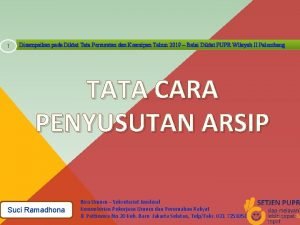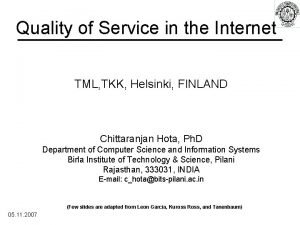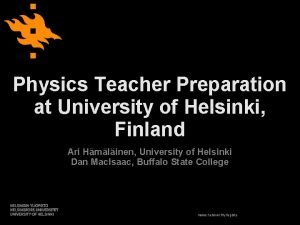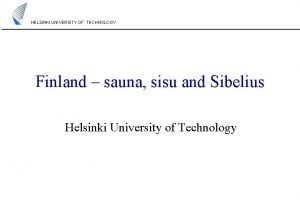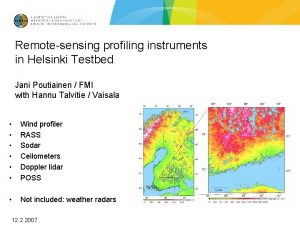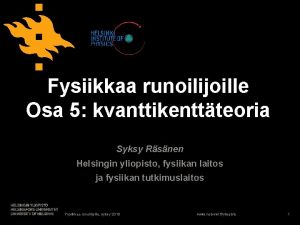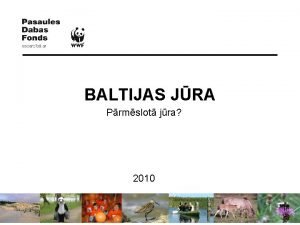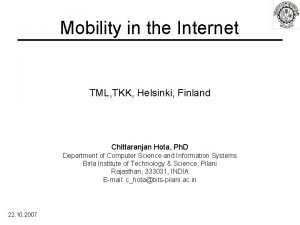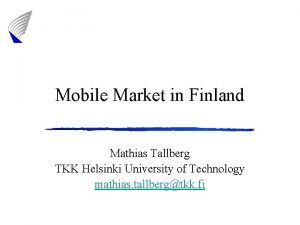TKK HELSINKI UNIVERSITY OF TECHNOLOGY EuroNF JRA 2









- Slides: 9

TKK HELSINKI UNIVERSITY OF TECHNOLOGY Euro-NF JRA 2. 3 meeting, 2. 10. 2008 Multi-user scheduling in HSDPA systems Samuli Aalto and Pasi Lassila Department of Communications and Networking TKK Helsinki University of Technology Email: {Samuli. Aalto, Pasi. Lassila}@tkk. fi 1(9)

TKK HELSINKI UNIVERSITY OF TECHNOLOGY Euro-NF JRA 2. 3 meeting, 2. 10. 2008 HSDPA systems – Downlink scheduling • BS decides allocation of radio resources for different users’ traffic – Radio resource management • In HSDPA, resources = orthogonal codes • Each user terminal has a ”category” • Category defines the processing power limitation of the terminal Scheduling: – Based on user’s channel quality and terminal category a coding scheme and number of codes is used which determines the ”bit rate” – Scheduler should use all resources (i. e. , schedule multiple users) 2(9)

TKK HELSINKI UNIVERSITY OF TECHNOLOGY Euro-NF JRA 2. 3 meeting, 2. 10. 2008 3(9)

TKK HELSINKI UNIVERSITY OF TECHNOLOGY Euro-NF JRA 2. 3 meeting, 2. 10. 2008 Flow-level model (1) – Elastic flows with random sizes with a general distribution, Poisson arrivals with rate l • At time t there are N(t) flows, each flow is indexed by n – We do not consider fast fading • Flows only see average channel behavior • Flows have different channel’s due to, e. g. , distance to the base station – Codes correspond to servers • Number of servers denoted by K and servers indexed by k • The service rate of each server k is user dependent, denoted by rnk – e. g. , rate attenuates with distance dn, rnk ~ Min{1, (d 0/dn)a} • Aggregate rate is linear in number of codes (orthogonality) 4(9)

TKK HELSINKI UNIVERSITY OF TECHNOLOGY Euro-NF JRA 2. 3 meeting, 2. 10. 2008 Flow-level model (2) – Terminal category • Associated with each flow n is terminal category cn telling the number of codes – Due to terminal category constraints multiple flows need to be scheduled simultaneously (HSDPA systems) • Earlier we assumed all codes are given to exactly one user (old CDMA 1 x. EV-DO systems) • Multiple servers can serve one flow – classical multiserver problem assumes one server per queue (flow) • Servers are heterogeneous (service rate depends on flow) • Again, size-based information is used to select flows intelligently – Same problem formulation applies to OFDMA systems • Carriers correspond to codes 5(9)

TKK HELSINKI UNIVERSITY OF TECHNOLOGY Euro-NF JRA 2. 3 meeting, 2. 10. 2008 Problem reduction – Idea: First try to simplify the problem to the simplest possible system amenable to analysis • Gives insight for analyzing more complex scenarios – Assumptions • All flows have identical channels (symmetric situation) • All flows have the same terminal category so that K/2 codes can be allocated per user – Corresponds to an M/G/2 system (with homogenous servers) • Even for this system the optimal scheduling rule is not known (for minimizing mean flow delay) 6(9)

TKK HELSINKI UNIVERSITY OF TECHNOLOGY Euro-NF JRA 2. 3 meeting, 2. 10. 2008 Collection of useful results (found so far…) – In a static setting with a fixed number of flows SRPT is optimal 1 • Applies even with heterogeneous servers • Assumes one server / flow – In the dynamic setting • “long jobs are stuck at the end of the busy period” 2 – Gain from (size-based) scheduling • Impact greatest for M/G/1 queue • For M/G/n, as n increases, scheduling has less and less impact • In an M/G/∞ queue scheduling does not affect performance 1 2 Pinedo (1995) Wierman (2007) 7(9)

TKK HELSINKI UNIVERSITY OF TECHNOLOGY Euro-NF JRA 2. 3 meeting, 2. 10. 2008 Some tests for M/G/2 (relative to PS) Erlang flow sizes Pareto flow sizes SRPT/LRPT SRPT FCFS SRPT* Exponential flow sizes SRPT FCFS SRPT/LRPT SRPT* Det Erl Pareto Exp 8(9)

TKK HELSINKI UNIVERSITY OF TECHNOLOGY Euro-NF JRA 2. 3 meeting, 2. 10. 2008 Two forthcoming ACM MSWi. M 2008 papers – Pasi Lassila and Samuli Aalto ”Combining opportunistic and size-based scheduling in wireless systems” • studying how to optimally combine channel-aware and size-based scheduling of elastic flows in HSPDA/HDR type systems • channel-awareness exploits variations in the quality of the radio channel • size-based schduling gets rid of flows as soon as possible – Jarno Nousiainen, Jorma Virtamo and Pasi Lassila ”Forwarding capacity of an infinite wireless network” • studying the maximal forwarding capacity of a massively dense wireless multihop network • separation of micro (single hop) and macroscopic (end-to-end path) levels • formulation of the forwarding problem and development of simulation algorithms for obtaing upper bounds 9(9)
